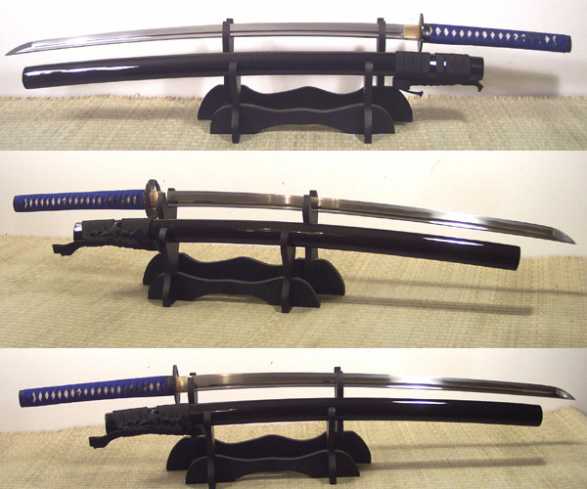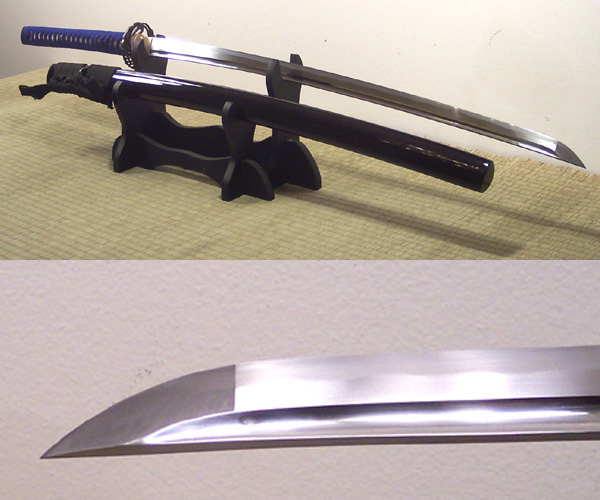Cheness 30" Nagasa 9260 Spring Steel Katana
DISCONTINUED
SOLD OUT & UNAVAILABLE
Extra Long 30" Blade for taller practitioners. Heavy, forward weighted balance.
With a blade a full two inches longer than your standard production Katana, the 30" Nagasa 9260 Spring Steel Katana was designed with Westerners over 6' tall in mind, especially those who enjoy their heavy duty cutting!
Made from the revolutionary 9260 Spring Steel this beast of a sword is fully capable of delivering truly awe inspiring cuts. While it may not be the most agile sword, it makes up for it by the sheer unstoppable force it can generate. A rare opportunity for a larger sized iai practitioner to pick up a longer sword without the expense of going custom, as well as just a great all round and super tough Dojo cutter for serious tameshigiri, the 30" Nagasa represents tremendous value for money.
MUST READ NOTE REGARDING CHENESS CUTLERY SWORDS
Cheness Cutlery Swords are designed by Martial Artists for Martial Artists. Their goal is and always has been to simply offer an affordable entry level practice sword to beginners in iaido and iaijutsu and when first released in 2005 truly revolutionized the sword market for until that time, there were few to no entry level Katana.
Cheness swords were never meant to be collectors pieces, display pieces, or art sword quality. There are numerous other manufacturers and individual smiths in the industry that serve those needs (click here for our full selection of Japanese swords). The reason being the same as with all other hobbies, refinement will come with a price.
Because of this, certain shortcuts must be taken in the manufacturing process and are NOT considered to be defects. Because of this, we will not accept returns on any swords that have the following features:
- The polish of each sword is a working polish known as a 'Tameshigiri' polish and is somewhere between 400 to 600 grit. As they are handmade and subject to extensive handling, they do get scuff marks and minor stains on the blade and components.
- Each blade is hand hammered, shaped to the eye, and then tempered and quenched. This process causes all types of steel to contract, twist and warp to some degree -with 9260 being one of the hardest steels to keep straight - so you should not expect the blade to be perfectly straight like a lazer. Even if slightly off center or imperfect, it will still cut perform for Tameshigiri and you can be confident in the tempering.
- The blades have considerable hira-niku (meat) on them for heavy cutting and will generally feel somewhat dull to the causal observer. It will not slice paper or shave hair off your arm. It WILL cut tatami mats or bamboo or other targets that were traditionally used to simulate human limbs. With only a little work however, it is quite possible to sharpen it to any degree desired.
- The cotton ito wrap is tight enough for use, but is not going to be as tight as silk or leather. Habaki, Seppa, Fuchigashira, etc are free floating and pinched into place by friction forces like a traditional Katana, but some minor adjustments may be necessary out of the box.
- Mekugi pegs are angled by design to create a wedge and optimize the double mekugi configuration. The bottom peg is made of brass, the top, bamboo which results in an overall stronger design and was recommended by a senior Japanese JSA Sensei.
In short, you should not expect an art sword or something perfect out of the box. You will almost certainly need to make some adjustments or even a complete DIY overhaul (we have many free tutorials on how to do this right here on the main SBG website). But for those of you who don't mind a rough and ready sword, or who wish to take it to a higher level, you will find these blades to be extremely long lasting, tough and worth every penny.
In summary, Cheness puts it like this:
The issues can all be addressed by the end user if they so choose. After receiving the sword, you can adjust the components, add a high-grit diamond paste polish, deburr the blade to slice paper, polish the components, etc. to make it as refined as you choose. However, these are not the features we strive for and should not be expected of the sword out of the box. If a highly refined sword is what you are after, you will either need to be prepared to perform these refinements yourself or should purchase a higher end sword from a different manufacturer.
Please note, as to be expected issues like cracked blades, broken handles, etc are of course subject to our standard warranties and return policies.
How to Use
Materials and Construction
Warranty Info
Return Policy
Featured positive reviews:
I initially bought this sword to replace a more expensive Hanwei sword I used for tameshigiri. I was too afraid I would mess up that sword so I wanted more of a beater sword. Out of the box the Cheness Nagasa wasn't as sharp as my Hanwei and I was a bit disappointed. I ended up sharpening the blade with a SOG knife sharpener and I was pleasantly surprised by the results. I really started to fall in love with the sword.
After a bunch of cutting, I liked it so much I decided to buy a second. At the time I was using a 29" Hanwei iaito for my iaido practice I had enough training in iaido, that my teacher was suggesting I get a longer sword. I ended up buying my second Nagasa. I dulled the first one down with a file and started using that as my iaito (I was still too chicken to use a live blade for iaido). The new one became my cutter. I really wanted to practice and cut with same sword, which I had not been doing.
The blade is really where Cheness puts the most focus. I can't complain much about that besides I had to sharpen it a bit. They cut some corners with the tsuka, saya and fittings. That's how they keep the costs so low.
The tsuka ito is a standard cotton wrap. Nothing fancy. It is tight. The blue is nice. It has held up well from use. They do not do the appropriate alternating handle wrap, which a traditional katana should have. It bothers me a bit now as similar priced swords (I.e. ronin katana) do the alternating wrap plus use silk.
The saya is where I have had the most issues. It's functional, but not really for heavy iaido usage. I have actually had some email discussions with Paul Chen about it. There is a seam close to the kurigata, that is lacquered over. It's very faint. But with a lot of saya manipulation in iaido, it's a weak point and I have cracked the laquer coating along that seam. Also, other companies are starting to use buffalo horn for parts of the saya at similar price points.
As a whole I still love the sword. I still cut with it but my iaito version has been retired for a much more expensive sword. I am even contemplating buying the international version that comes with the black ray skin and matte saya.
I would definitely recommend it, and all of Cheness' line if you want to do some backyard cutting. I would recommend it for a tall, entry level iaido practioner who is on a budget and doesn't want to spend more than double on a custom zinc aluminum alloy iaito from Japan. It's not the sword for a really seasoned iaido practioner.









